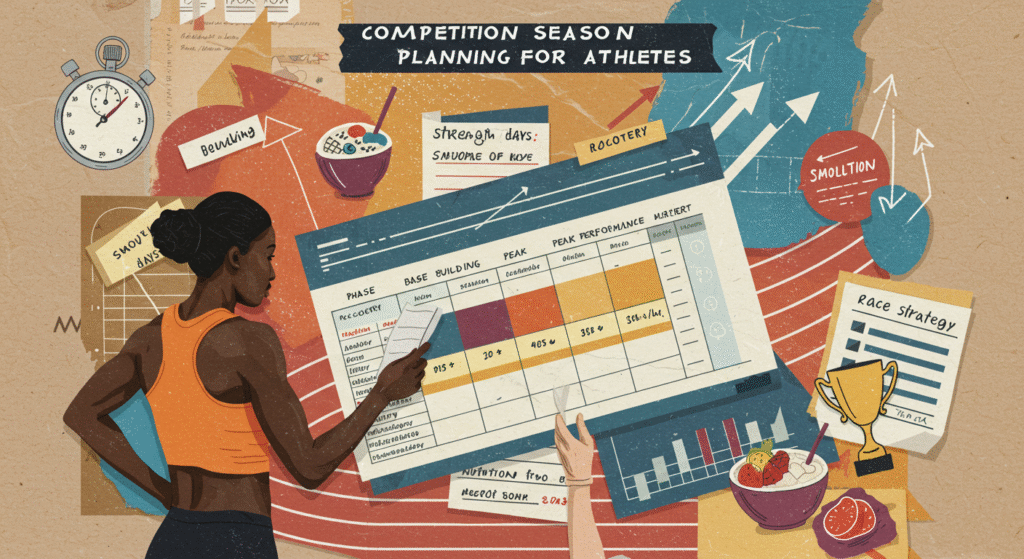Competition Season Planning: Introduction
Navigating a competitive sports season requires more than just talent and hard work—it demands strategic planning and thoughtful execution. Whether you’re an athlete aiming for personal bests or a coach developing a team’s potential, how you structure your competitive calendar can make or break your season. The difference between champions and competitors often lies not in ability, but in their approach to season planning.
Properly planning your competition season can help optimize athletic performance, ensure balanced training cycles, and prevent the dreaded mid-season burnout that sidelines even the most promising athletes. This systematic approach isn’t just for elite performers—athletes at all levels benefit from intentional season planning.
In this comprehensive guide, we’ll explore essential strategies for effective competition scheduling and sports season management, empowering athletes and coaches to achieve their peak performance while maintaining overall well-being. From goal-setting frameworks to recovery protocols, you’ll discover actionable insights to transform your approach to competition planning and elevate your athletic experience.
Competition Season Planning: Set Clear Goals and Objectives
The journey to athletic excellence begins with a roadmap—specifically, with clearly defined goals that provide direction and purpose to your training and competition efforts. Without specific targets, athletes risk directionless training that fails to build toward meaningful achievements.
Goal-setting for a competition season isn’t merely about declaring “I want to win”—it requires thoughtful consideration of what success truly means for you. For some athletes, this might involve qualifying times or distances, while others may focus on technical improvements or competitive rankings.
Effective athletic goals follow the SMART framework—Specific, Measurable, Achievable, Relevant, and Time-bound. For example, rather than saying, “I want to improve my marathon time,” a SMART goal would be, “I aim to reduce my marathon time by 10 minutes at the Boston Marathon in April by improving my lactate threshold through targeted training.”
When planning your competition season, create a hierarchy of goals that includes:
– Primary season goals (1-2 major achievements)
– Secondary objectives (development targets that support your primary goals)
– Process goals (daily and weekly behaviors that lead to improvement)
Remember that your competition schedule should support these goals, not dictate them. Many athletes make the mistake of entering competitions simply because they’re available, rather than strategically selecting events that advance their specific objectives.
- Define short-term and long-term performance goals.
- Align training objectives with competition schedules.
- Regularly review and adjust goals based on progress.

Competition Season Planning: Develop a Structured Training Plan
A well-structured training plan serves as the architectural blueprint for your athletic success. Without this systematic approach, athletes risk inconsistent performance, plateaus, and increased injury potential. The most effective training plans embrace periodization—the systematic variation of training variables over specific timeframes to optimize performance for target competitions.
When developing your season’s training structure, consider dividing your program into these key phases:
- Preparation Phase (Base Building): This initial phase focuses on developing foundational fitness, technical skills, and strength. During this period, training volume is typically high while intensity remains moderate. Competition during this phase should be limited and primarily used as training opportunities rather than performance targets.
- Pre-Competition Phase: As you approach your competitive season, training shifts toward more sport-specific preparation. Volume gradually decreases while intensity increases. Technical refinement becomes paramount, and competitions may be incorporated as fitness tests.
- Competition Phase: During this peak period, training volume decreases significantly while intensity remains high. Recovery between sessions becomes crucial, and training focuses on maintaining fitness while sharpening competitive skills. Your most important competitions should fall within this phase when you’re physiologically primed for peak performance.
- Transition Phase: Following the competitive season, this recovery-focused period allows for physical and mental rejuvenation. Active recovery, cross-training, and reduced structured training characterize this phase, which prevents long-term burnout and prepares the body for the next training cycle.
Within these broader phases, implement microcycles (typically weekly training patterns) that include appropriate variation in training stimulus. The classic hard day/easy day approach ensures adequate recovery while still providing progressive overload.
Case Study: Elite distance runner Molly Huddle structures her annual plan around two peak racing seasons, with distinct preparation, competition, and transition phases for each. This deliberate approach allowed her to set American records in multiple events while maintaining career longevity.
- Divide the season into distinct phases: preparation, competition, and transition.
- Incorporate periodization to vary training intensity and focus.
- Allocate time for skill development, strength training, and endurance building.
Competition Season Planning: Incorporate Rest and Recovery Periods
The paradox of athletic improvement is that progress happens not during training but during recovery. Yet in the competitive sports landscape, rest is often viewed as a weakness rather than the essential performance enhancer it truly is. A strategic approach to competition season planning must prioritize recovery as deliberately as it does training stimulus.
Recovery operates on multiple timescales within your season plan:
– Daily recovery: The hours between training sessions where muscle repair, glycogen replenishment, and nervous system restoration occur. Quality sleep (7-9 hours for most athletes), proper nutrition, and stress management form the foundation of daily recovery.
– Weekly recovery: Structured easy days and complete rest days within your microcycle allow for deeper recovery. Many successful programs follow a 3:1 loading pattern—three progressively challenging days followed by an easy recovery day.
– Seasonal recovery: Planned reduction weeks (often every 3-4 weeks) where training volume decreases by 30-40% allow for supercompensation and prevent accumulated fatigue. These recovery blocks should be scheduled proactively, not reactively after burnout signs appear.
– Post-competition recovery: The more significant the competition, the more recovery time needed afterward. For major events, allow 1-3 days of active recovery before resuming normal training.
Effective recovery strategies extend beyond simply taking time off. Active recovery modalities have shown significant benefits for performance restoration:
– Low-intensity aerobic exercise (heart rate below 60% of maximum)
– Mobility work and dynamic flexibility training
– Hydrotherapy contrasts (alternating cold and warm water immersion)
– Compression garments for enhanced blood flow
– Manual therapy and self-myofascial release techniques
The most critical aspect of recovery planning is individualization. Recovery needs vary tremendously between athletes based on age, training history, genetic factors, and stress levels. Implement objective monitoring tools such as morning heart rate, perceived exertion scales, and performance metrics to gauge recovery status rather than following generic protocols.
- Schedule regular rest days and lighter training weeks.
- Utilize active recovery techniques such as stretching and low-impact exercises.
- Monitor athlete fatigue and adjust training loads accordingly.

Competition Season Planning: Conclusion
Strategically planning your competition season represents the difference between reaching your athletic potential and falling short of your capabilities. Throughout this guide, we’ve explored the fundamental elements that contribute to optimal season design—goal setting that provides direction, structured training that builds progressively toward peak performance, recovery protocols that enhance adaptation, and monitoring systems that enable timely adjustments.
The most successful athletes aren’t necessarily those with the greatest natural talents, but rather those who approach their competitive seasons with intention and intelligence. By implementing the frameworks and strategies outlined here, you position yourself to maximize performance when it matters most while simultaneously protecting your long-term athletic development and well-being.
Remember that effective season planning isn’t about creating the perfect schedule—it’s about developing a thoughtful approach that balances competitive ambition with sustainable training practices. Each season becomes a learning opportunity, informing and improving your planning process for future competitive cycles.
As you implement these strategies, maintain perspective on what truly constitutes athletic success. While medals and records provide tangible validation, the most rewarding aspects of sport often come from the process itself—the daily pursuit of excellence, the problem-solving required to overcome challenges, and the self-knowledge gained through pushing your limits.
Begin today by assessing your current approach to season planning. Identify one area where you can implement immediate improvements, whether in goal clarity, training structure, recovery practices, or performance monitoring. This single step toward more strategic season planning may well be the catalyst that elevates your athletic journey to new heights.
Coach Otto is a certified track and field coach with over 15 years of experience working with high jumpers at high school, collegiate, and elite levels.

